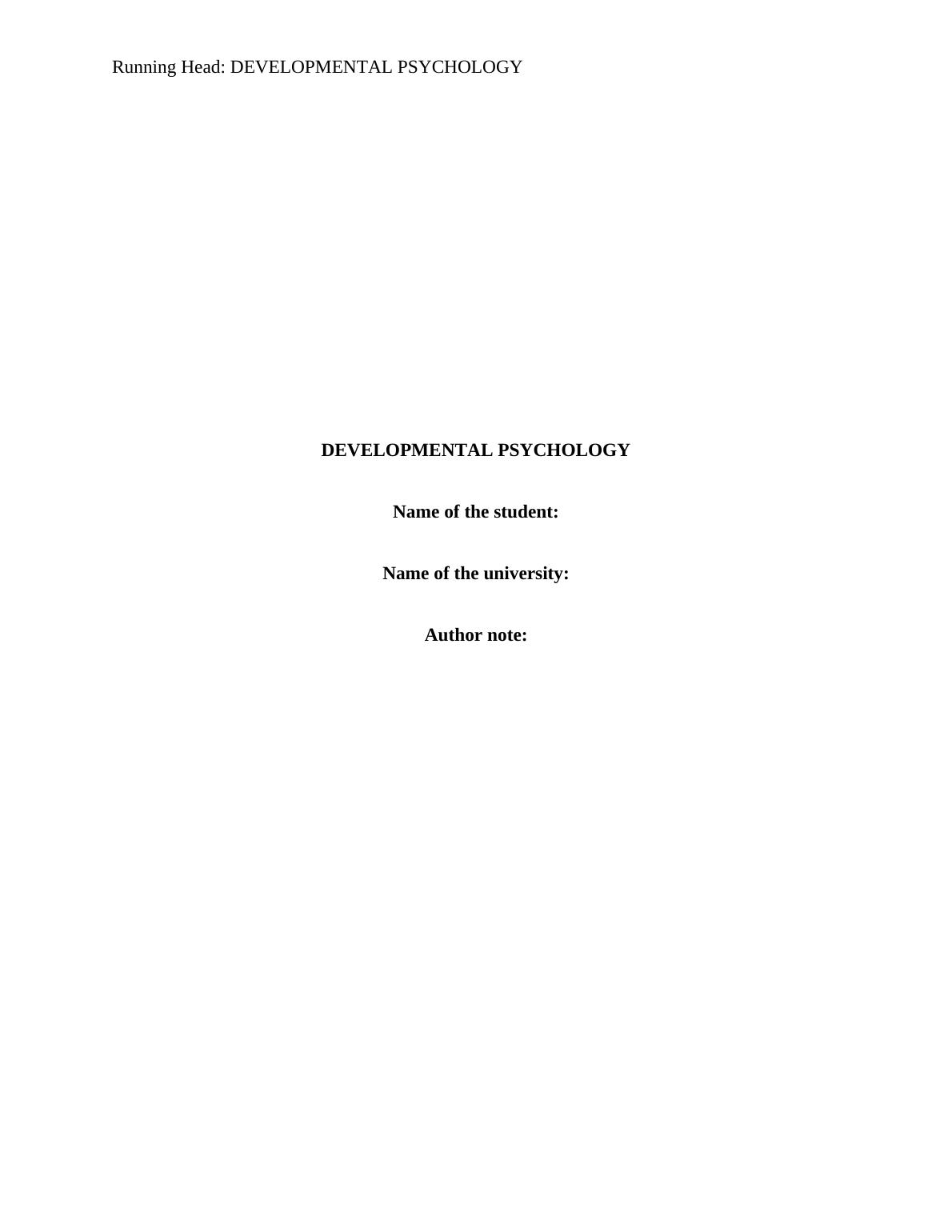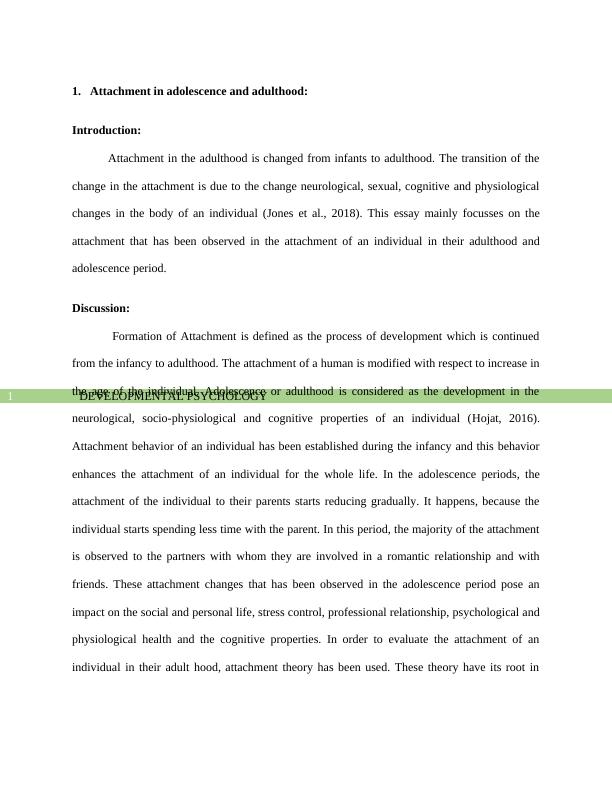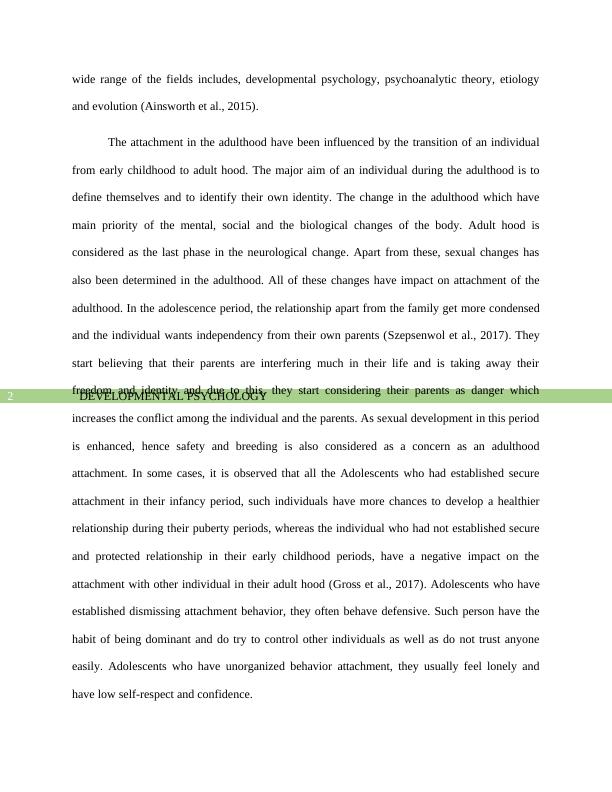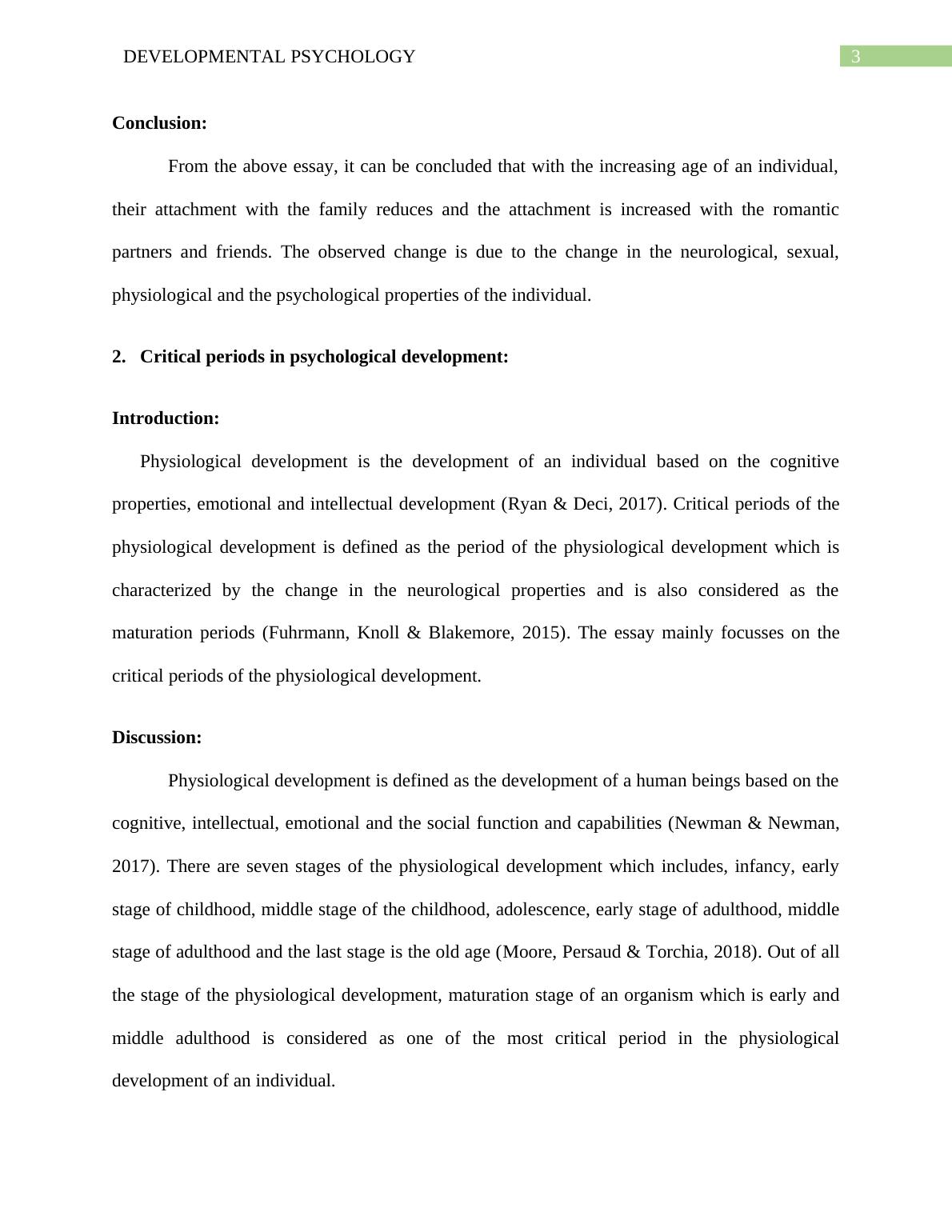Attachment in Adolescence and Adulthood
Added on 2022-11-24
15 Pages3827 Words87 Views
Running Head: DEVELOPMENTAL PSYCHOLOGY
DEVELOPMENTAL PSYCHOLOGY
Name of the student:
Name of the university:
Author note:
DEVELOPMENTAL PSYCHOLOGY
Name of the student:
Name of the university:
Author note:

DEVELOPMENTAL PSYCHOLOGY1
1. Attachment in adolescence and adulthood:
Introduction:
Attachment in the adulthood is changed from infants to adulthood. The transition of the
change in the attachment is due to the change neurological, sexual, cognitive and physiological
changes in the body of an individual (Jones et al., 2018). This essay mainly focusses on the
attachment that has been observed in the attachment of an individual in their adulthood and
adolescence period.
Discussion:
Formation of Attachment is defined as the process of development which is continued
from the infancy to adulthood. The attachment of a human is modified with respect to increase in
the age of the individual. Adolescence or adulthood is considered as the development in the
neurological, socio-physiological and cognitive properties of an individual (Hojat, 2016).
Attachment behavior of an individual has been established during the infancy and this behavior
enhances the attachment of an individual for the whole life. In the adolescence periods, the
attachment of the individual to their parents starts reducing gradually. It happens, because the
individual starts spending less time with the parent. In this period, the majority of the attachment
is observed to the partners with whom they are involved in a romantic relationship and with
friends. These attachment changes that has been observed in the adolescence period pose an
impact on the social and personal life, stress control, professional relationship, psychological and
physiological health and the cognitive properties. In order to evaluate the attachment of an
individual in their adult hood, attachment theory has been used. These theory have its root in
1. Attachment in adolescence and adulthood:
Introduction:
Attachment in the adulthood is changed from infants to adulthood. The transition of the
change in the attachment is due to the change neurological, sexual, cognitive and physiological
changes in the body of an individual (Jones et al., 2018). This essay mainly focusses on the
attachment that has been observed in the attachment of an individual in their adulthood and
adolescence period.
Discussion:
Formation of Attachment is defined as the process of development which is continued
from the infancy to adulthood. The attachment of a human is modified with respect to increase in
the age of the individual. Adolescence or adulthood is considered as the development in the
neurological, socio-physiological and cognitive properties of an individual (Hojat, 2016).
Attachment behavior of an individual has been established during the infancy and this behavior
enhances the attachment of an individual for the whole life. In the adolescence periods, the
attachment of the individual to their parents starts reducing gradually. It happens, because the
individual starts spending less time with the parent. In this period, the majority of the attachment
is observed to the partners with whom they are involved in a romantic relationship and with
friends. These attachment changes that has been observed in the adolescence period pose an
impact on the social and personal life, stress control, professional relationship, psychological and
physiological health and the cognitive properties. In order to evaluate the attachment of an
individual in their adult hood, attachment theory has been used. These theory have its root in

DEVELOPMENTAL PSYCHOLOGY2
wide range of the fields includes, developmental psychology, psychoanalytic theory, etiology
and evolution (Ainsworth et al., 2015).
The attachment in the adulthood have been influenced by the transition of an individual
from early childhood to adult hood. The major aim of an individual during the adulthood is to
define themselves and to identify their own identity. The change in the adulthood which have
main priority of the mental, social and the biological changes of the body. Adult hood is
considered as the last phase in the neurological change. Apart from these, sexual changes has
also been determined in the adulthood. All of these changes have impact on attachment of the
adulthood. In the adolescence period, the relationship apart from the family get more condensed
and the individual wants independency from their own parents (Szepsenwol et al., 2017). They
start believing that their parents are interfering much in their life and is taking away their
freedom and identity and due to this, they start considering their parents as danger which
increases the conflict among the individual and the parents. As sexual development in this period
is enhanced, hence safety and breeding is also considered as a concern as an adulthood
attachment. In some cases, it is observed that all the Adolescents who had established secure
attachment in their infancy period, such individuals have more chances to develop a healthier
relationship during their puberty periods, whereas the individual who had not established secure
and protected relationship in their early childhood periods, have a negative impact on the
attachment with other individual in their adult hood (Gross et al., 2017). Adolescents who have
established dismissing attachment behavior, they often behave defensive. Such person have the
habit of being dominant and do try to control other individuals as well as do not trust anyone
easily. Adolescents who have unorganized behavior attachment, they usually feel lonely and
have low self-respect and confidence.
wide range of the fields includes, developmental psychology, psychoanalytic theory, etiology
and evolution (Ainsworth et al., 2015).
The attachment in the adulthood have been influenced by the transition of an individual
from early childhood to adult hood. The major aim of an individual during the adulthood is to
define themselves and to identify their own identity. The change in the adulthood which have
main priority of the mental, social and the biological changes of the body. Adult hood is
considered as the last phase in the neurological change. Apart from these, sexual changes has
also been determined in the adulthood. All of these changes have impact on attachment of the
adulthood. In the adolescence period, the relationship apart from the family get more condensed
and the individual wants independency from their own parents (Szepsenwol et al., 2017). They
start believing that their parents are interfering much in their life and is taking away their
freedom and identity and due to this, they start considering their parents as danger which
increases the conflict among the individual and the parents. As sexual development in this period
is enhanced, hence safety and breeding is also considered as a concern as an adulthood
attachment. In some cases, it is observed that all the Adolescents who had established secure
attachment in their infancy period, such individuals have more chances to develop a healthier
relationship during their puberty periods, whereas the individual who had not established secure
and protected relationship in their early childhood periods, have a negative impact on the
attachment with other individual in their adult hood (Gross et al., 2017). Adolescents who have
established dismissing attachment behavior, they often behave defensive. Such person have the
habit of being dominant and do try to control other individuals as well as do not trust anyone
easily. Adolescents who have unorganized behavior attachment, they usually feel lonely and
have low self-respect and confidence.

DEVELOPMENTAL PSYCHOLOGY3
Conclusion:
From the above essay, it can be concluded that with the increasing age of an individual,
their attachment with the family reduces and the attachment is increased with the romantic
partners and friends. The observed change is due to the change in the neurological, sexual,
physiological and the psychological properties of the individual.
2. Critical periods in psychological development:
Introduction:
Physiological development is the development of an individual based on the cognitive
properties, emotional and intellectual development (Ryan & Deci, 2017). Critical periods of the
physiological development is defined as the period of the physiological development which is
characterized by the change in the neurological properties and is also considered as the
maturation periods (Fuhrmann, Knoll & Blakemore, 2015). The essay mainly focusses on the
critical periods of the physiological development.
Discussion:
Physiological development is defined as the development of a human beings based on the
cognitive, intellectual, emotional and the social function and capabilities (Newman & Newman,
2017). There are seven stages of the physiological development which includes, infancy, early
stage of childhood, middle stage of the childhood, adolescence, early stage of adulthood, middle
stage of adulthood and the last stage is the old age (Moore, Persaud & Torchia, 2018). Out of all
the stage of the physiological development, maturation stage of an organism which is early and
middle adulthood is considered as one of the most critical period in the physiological
development of an individual.
Conclusion:
From the above essay, it can be concluded that with the increasing age of an individual,
their attachment with the family reduces and the attachment is increased with the romantic
partners and friends. The observed change is due to the change in the neurological, sexual,
physiological and the psychological properties of the individual.
2. Critical periods in psychological development:
Introduction:
Physiological development is the development of an individual based on the cognitive
properties, emotional and intellectual development (Ryan & Deci, 2017). Critical periods of the
physiological development is defined as the period of the physiological development which is
characterized by the change in the neurological properties and is also considered as the
maturation periods (Fuhrmann, Knoll & Blakemore, 2015). The essay mainly focusses on the
critical periods of the physiological development.
Discussion:
Physiological development is defined as the development of a human beings based on the
cognitive, intellectual, emotional and the social function and capabilities (Newman & Newman,
2017). There are seven stages of the physiological development which includes, infancy, early
stage of childhood, middle stage of the childhood, adolescence, early stage of adulthood, middle
stage of adulthood and the last stage is the old age (Moore, Persaud & Torchia, 2018). Out of all
the stage of the physiological development, maturation stage of an organism which is early and
middle adulthood is considered as one of the most critical period in the physiological
development of an individual.

End of preview
Want to access all the pages? Upload your documents or become a member.
Related Documents
Examining the Developmental Period of Young Adulthoodlg...
|9
|2613
|53
England Journal of Medicinelg...
|6
|1551
|20
Life-cycle Development and Needs of Jacoblg...
|12
|4316
|40
Assignment on Psychological Perspective Healthlg...
|9
|2157
|88
Human Development Across the Lifespanlg...
|7
|1625
|393
Adolescence and Cognitive Enhancement: Importance of Physical Activitylg...
|31
|9260
|56
